

Birds (Aves or avian dinosaurs) range in size
and weight from the 5 cm (2 in) and 1.6-2 grams bee hummingbird to the 2.75 m (9 ft) and 104-156 kg (229-344 lbs) ostrich.
Birds are from one of six basic animal groups,
with the others being amphibians, fish, invertebrates, mammals, and reptiles.
They are endothermic vertebrates, characterized by feathers, toothless beaked jaws,
a high metabolic rate, a four-chambered heart,
and a lightweight but strong skeleton.
They reproduce by laying hard-shelled eggs
(eggs fertilize inside the female).
The fossil record indicates that birds are the last surviving group of dinosaurs .
So, they are also termed avian dinosaurs .

Birds are “avian dinosaurs”
Ask a paleontologist who
is familiar with the phylogeny
of vertebrates and they will probably tell you that birds (avians) are dinosaurs .
Using proper terminology,
birds are avian dinosaurs ;
while other dinosaurs are non-avian dinosaurs, and, strange
as it may sound, birds are technically considered reptiles .

The Dalmatian pelican
(Pelecanus crispus) is among the world’s heaviest flying
bird species.
It measures 160 to 183 cm
(5 feet 3 inches to 6 feet
0 inches) in length,
7.25-15 kg (16.0-33.1 lb)
in weight, and 290-345 cm
(9 ft 6 in–11 ft 4 in)
in wingspan.
It breeds from southeastern Europe to India and China.

Andean condor (Vultur gryphus) can reach
a weight of 11 to 15 kg (24 to 33 lb) for males and 8 to 11 kg (18 to 24 lb) for females. Overall length can range from 100 to 130 cm (3 feet 3 inches to 4 feet 3 inches).
It also has a very large wingspan, up to
3.3 m (10 ft 10 in), exceeded only by the wingspans of four seabirds and water birds (the wandering albatross, southern royal albatross, great white pelican,
and Dalmatian pelican).
Andean condor plays an important role
in the folklore and mythology of the South American Andean regions.
It is a national symbol of Argentina, Bolivia, Chile, Colombia, Ecuador, Peru, and Venezuelan Andes states. It is the national bird of Bolivia, Chile, Colombia, and Ecuador.
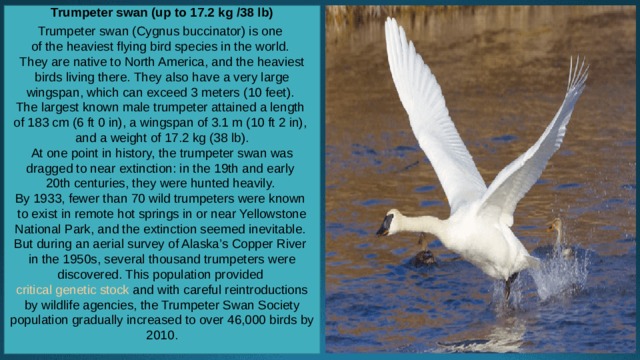
Trumpeter swan (up to 17.2 kg /38 lb)
Trumpeter swan (Cygnus buccinator) is one
of the heaviest flying bird species in the world.
They are native to North America, and the heaviest birds living there. They also have a very large wingspan, which can exceed 3 meters (10 feet).
The largest known male trumpeter attained a length
of 183 cm (6 ft 0 in), a wingspan of 3.1 m (10 ft 2 in),
and a weight of 17.2 kg (38 lb).
At one point in history, the trumpeter swan was dragged to near extinction: in the 19th and early
20th centuries, they were hunted heavily.
By 1933, fewer than 70 wild trumpeters were known
to exist in remote hot springs in or near Yellowstone National Park, and the extinction seemed inevitable.
But during an aerial survey of Alaska’s Copper River
in the 1950s, several thousand trumpeters were discovered. This population provided critical genetic stock and with careful reintroductions by wildlife agencies, the Trumpeter Swan Society population gradually increased to over 46,000 birds by 2010.

Great bustard and Kori bustard (up to 18 kg / 40 lb), the heaviest living flying animal The Great bustard (Otis tarda) and Kori bustard are probably the heaviest living flying animal.
The Great bustard can be seen in central/south Europa and temperate Asia.
But Portugal and Spain now contain about 60% of the world’s Great bustard population.
A male Great bustard is typically 90–105 cm
(2 ft 11 in-3 ft 5 in) tall, with a length of around 115 cm (3 ft 9 in), and has a 2.1-2.7 m (6 ft 11 in-8 ft 10 in) wingspan.
The male can range in weight from 5.8 to 18 kg (13 to 40 lb).
Females are much smaller, weighing from 3.1
to 8 kg (6.8 to 17.6 lb).

King penguin (up to 18+ kg / 40+ lb) The average weight of the King penguin (Aptenodytes patagonicus) is similar
or just slightly higher than that of the largest living flying birds – the Great bustard and the Kori bustard.
They stand at 70 to 100 cm (28 to 39 in) tall and weighs from 9.3 to 18 kg
(21 to 40 lb).
Males are slightly larger than females.
It is the second-largest species of penguin (the largest is the Emperor penguin).
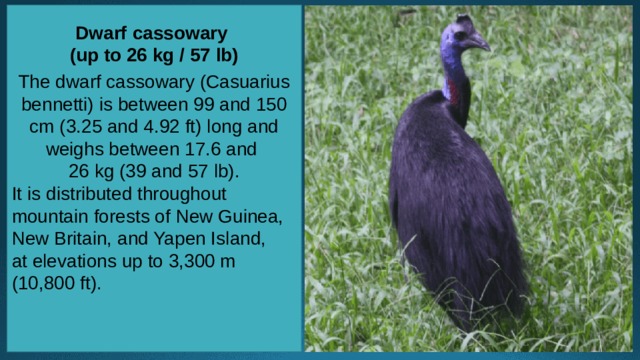
Dwarf cassowary
(up to 26 kg / 57 lb) The dwarf cassowary (Casuarius bennetti) is between 99 and 150 cm (3.25 and 4.92 ft) long and weighs between 17.6 and
26 kg (39 and 57 lb).
It is distributed throughout mountain forests of New Guinea, New Britain, and Yapen Island,
at elevations up to 3,300 m (10,800 ft).
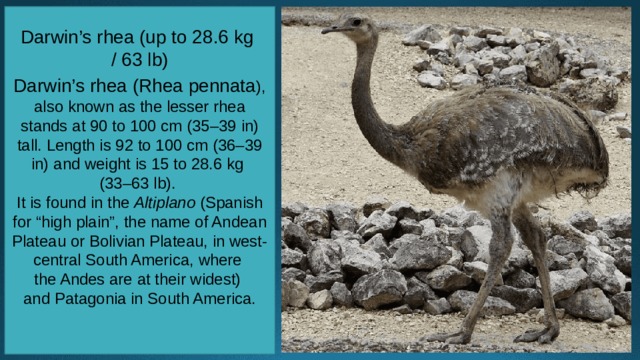
Darwin’s rhea (up to 28.6 kg
/ 63 lb) Darwin’s rhea (Rhea pennata ), also known as the lesser rhea stands at 90 to 100 cm (35–39 in) tall. Length is 92 to 100 cm (36–39 in) and weight is 15 to 28.6 kg
(33–63 lb).
It is found in the Altiplano (Spanish for “high plain”, the name of Andean Plateau or Bolivian Plateau, in west-central South America, where
the Andes are at their widest)
and Patagonia in South America.
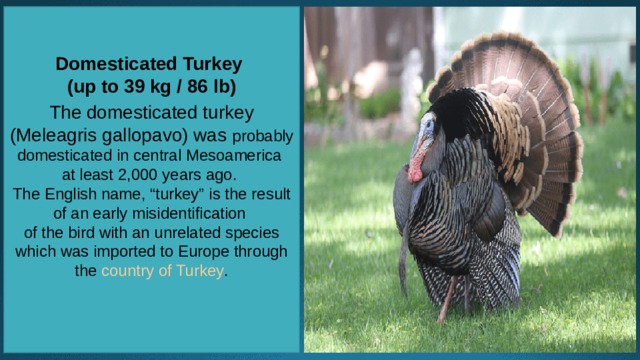
Domesticated Turkey
(up to 39 kg / 86 lb) The domesticated turkey (Meleagris gallopavo) was probably domesticated in central Mesoamerica
at least 2,000 years ago.
The English name, “turkey” is the result of an early misidentification
of the bird with an unrelated species which was imported to Europe through the country of Turkey .

Greater rhea (up to 40 kg
/ 88 lb) 20-40 kilograms (44-88 lb),
the greater rhea
(Rhea americana)
is the largest bird on the American continent.
Their strong powerful legs allow them to run up to 35 mph
(56 km/h).
The greater rhea is endemic
to Argentina, Bolivia, Brazil, Paraguay, and Uruguay.

Emperor penguin (up to 45 kg /
99 lb) Emperor penguin (Aptenodytes forsteri) is endemic to Antarctica .
Reaching 130 cm (51 in) in height and weighing from 22 to 45 kg
(49 to 99 lb),
it is the tallest and heaviest of all living penguin species.
The male and female emperor penguins are similar in plumage
and size.
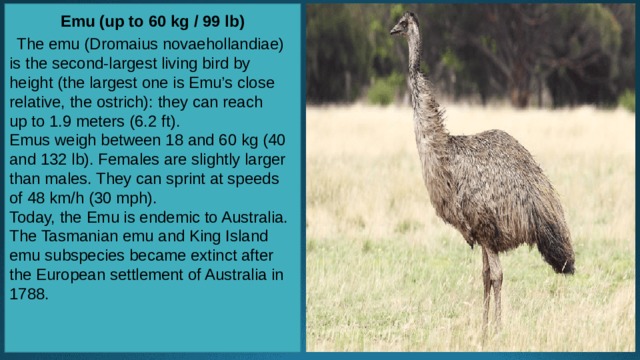
Emu (up to 60 kg / 99 lb) The emu (Dromaius novaehollandiae)
is the second-largest living bird by height (the largest one is Emu’s close relative, the ostrich): they can reach
up to 1.9 meters (6.2 ft).
Emus weigh between 18 and 60 kg (40 and 132 lb). Females are slightly larger than males. They can sprint at speeds of 48 km/h (30 mph).
Today, the Emu is endemic to Australia.
The Tasmanian emu and King Island emu subspecies became extinct after the European settlement of Australia in 1788.

Northern cassowary
(up to 70 kg / 154 lb) Northern cassowary (Casuarius unappendiculatus) is a large, bulky bird native to northern New Guinea . Females can weigh up
to 70 kg (154 lb), with an average weight of 58 kg (128 lb).
Males are smaller.
Despite its stocky build, a Northern cassowary can sprint up to 50 kilometers per hour
(31 miles per hour).
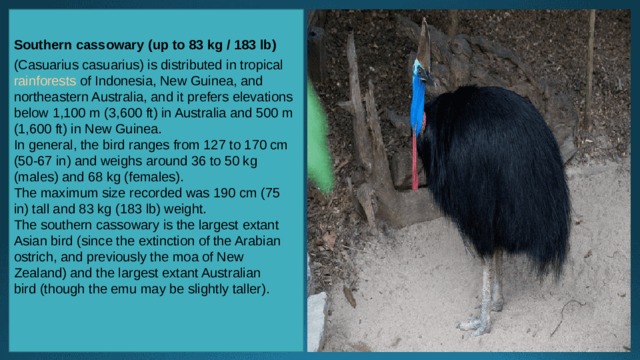
Southern cassowary (up to 83 kg / 183 lb)
(Casuarius casuarius) is distributed in tropical rainforests of Indonesia, New Guinea, and northeastern Australia, and it prefers elevations below 1,100 m (3,600 ft) in Australia and 500 m (1,600 ft) in New Guinea.
In general, the bird ranges from 127 to 170 cm (50-67 in) and weighs around 36 to 50 kg (males) and 68 kg (females).
The maximum size recorded was 190 cm (75 in) tall and 83 kg (183 lb) weight.
The southern cassowary is the largest extant Asian bird (since the extinction of the Arabian ostrich, and previously the moa of New Zealand) and the largest extant Australian
bird (though the emu may be slightly taller).
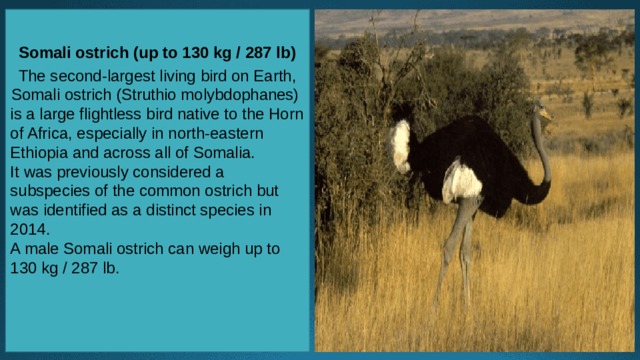
Somali ostrich (up to 130 kg / 287 lb) The second-largest living bird on Earth, Somali ostrich (Struthio molybdophanes)
is a large flightless bird native to the Horn of Africa, especially in north-eastern Ethiopia and across all of Somalia.
It was previously considered a subspecies of the common ostrich but was identified as a distinct species in 2014.
A male Somali ostrich can weigh up to 130 kg / 287 lb.
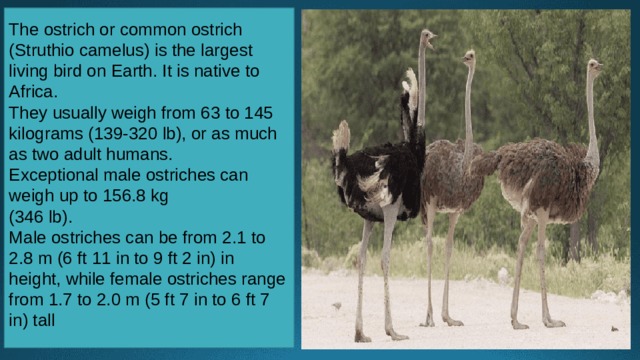
The ostrich or common ostrich (Struthio camelus) is the largest living bird on Earth. It is native to Africa.
They usually weigh from 63 to 145 kilograms (139-320 lb), or as much as two adult humans.
Exceptional male ostriches can weigh up to 156.8 kg
(346 lb).
Male ostriches can be from 2.1 to 2.8 m (6 ft 11 in to 9 ft 2 in) in height, while female ostriches range from 1.7 to 2.0 m (5 ft 7 in to 6 ft 7 in) tall
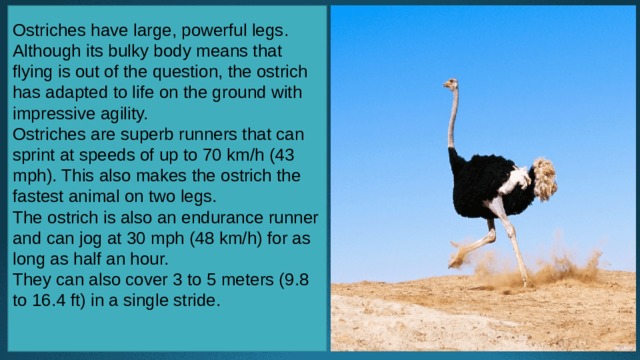
Ostriches have large, powerful legs. Although its bulky body means that flying is out of the question, the ostrich has adapted to life on the ground with impressive agility.
Ostriches are superb runners that can sprint at speeds of up to 70 km/h (43 mph). This also makes the ostrich the fastest animal on two legs.
The ostrich is also an endurance runner and can jog at 30 mph (48 km/h) for as long as half an hour.
They can also cover 3 to 5 meters (9.8 to 16.4 ft) in a single stride.



































